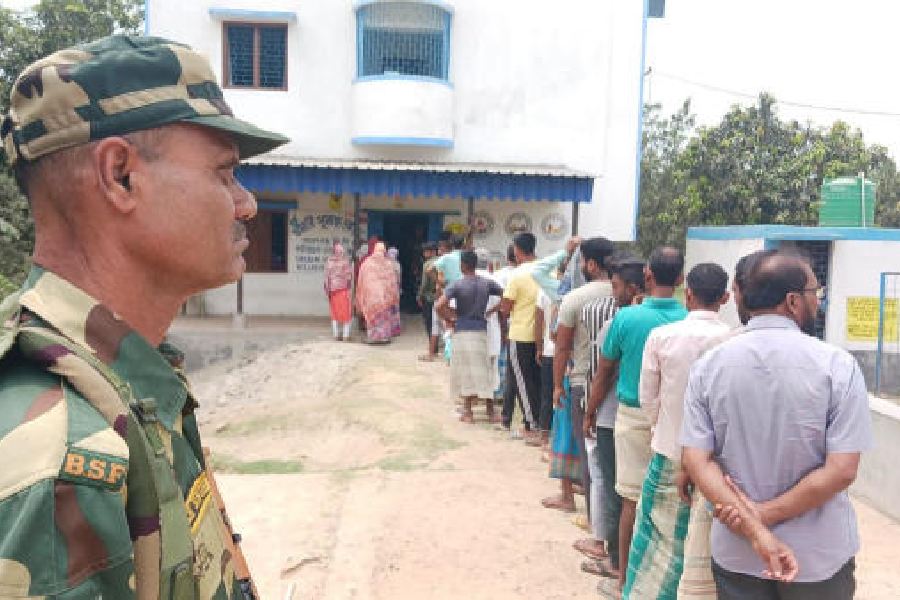Malda Uttar and Dakshin, as well as Murshidabad and Jangipur, which went to polls in the third phase on Tuesday, witnessed the lowest voter turnout in the past 40 years.
Despite a history of consistently recording over 80 per cent turnout in the last few elections, the average polling percentage for these seats came down to around 77 per cent.
Compared to the past two parliamentary elections, there has been a decline of nearly 4 per cent this time. In both 2019 and 2014, the four constituencies saw an average voter turnout of 81.66 and 81.85 per cent, respectively. However, in the current Lok Sabha election, this figure dropped to 77.53 per cent.
Murshidabad, historically known for high voter participation, recorded 81.52 per cent in this election, making it the lowest turnout in the last 40 years. In the 1980 Lok Sabha polls, Murshidabad recorded a turnout of 80.31 per cent, less than the current polling percentage. Similarly, Jangipur registered a turnout of only 73.71 per cent, its lowest since 1977 when it was 58.07 per cent.
In Malda district, comprising Malda Dakshin and Malda Uttar constituencies, the voter turnout was dishearteningly low at 76.36 per cent overall. While Malda Dakshin recorded 76.69 per cent, Malda Uttar's score was 76.03 per cent. Prior to this, the district only saw a turnout of 75.54 per cent in 1980, when it was a single constituency. Following delimitation in 2004, Malda was divided into Dakshin and Uttar constituencies.
While the Election Commission attributed the low polling percentage largely to stringent security and the removal of fake voters from the lists, many political analysts argued that increased absenteeism, likely due to people migrating to other states, and a growing disillusionment with the democratic process because of political corruption as the primary factors behind this decline.
The installation of CCTV cameras in all the polling stations and the strategic deployment of central forces have contributed significantly in keeping away unwanted elements from the election process, poll panel sources said.
“The commission also had given unprecedented importance to the corrections in the voter list to weed out fake voters. There was hardly any complaint of false voting in this election. Only genuine voters exercised their franchise. We want more participation but not false voting,” an EC official said.
While the EC expressed satisfaction with the fairness of the polling, political analysts believe that absentee voters and public apathy toward engaging in the democratic process, possibly due to widespread political corruption in recent months, may have significantly contributed to the low voter turnout in this election.
"Many migrant workers in Bengal hail from Cooch Behar, Murshidabad, Malda and South 24-Parganas. Before the Covid-19 pandemic, they would return to the state to vote. However, since and after the pandemic, their visits (home to vote) have ceased, which is a major factor in the low voter turnout," political analyst Biswanath Chakraborty said.
A member of the West Bengal Migrant Workers' Welfare Board said some 2.2 million migrant workers had registered on the Karmasathi-Parijayee Shramik portal, a dedicated database for Bengal's migrant workers. However, the board estimates the current migrant workforce to be close to 4 million.
Certain political analysts argue that the decline in voter turnout is not confined to Bengal alone but extends nationwide, but cautioned against jumping to conclusions such as anti-incumbency.
This trend isn't isolated to the third phase. The earlier two phases also witnessed low turnout. In the initial phase of the elections, Cooch Behar, Alipurduar and Jalpaiguri districts collectively saw an average voter turnout of 81.9 per cent. In comparison, during the 2019 and 2014 Lok Sabha polls, these districts averaged turnouts of 84.7 per cent and 83.6 per cent, respectively. Similarly, in the second phase, Balurghat, Darjeeling and Raiganj recorded an average voter turnout of 76.67 per cent. In contrast, during the 2019 and 2014 Lok Sabha elections, these areas averaged turnouts of 80.77 per cent and 82.16 per cent, respectively.
“Rampant corruption, violence in every form of election and the failure of politicians to fulfil promises have created apathy among people. They prefer to stay away from the election because it is actually not giving them anything. Politicians and the Election Commission will have to think carefully in order to bring people to voting queues,” political observer Rajagopal Dhar Chakraborty said.











